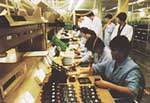|
Mumbai: With Satyam Computers setting up a unit in Shangh ai, the Indian software major became the latest member of the burgeoning club of multinational companies that hope to make a killing from Chinas open-door policy. After remaining an iron-wall country for more than four decades, starting with Chairman Mao Dsedongs rule, China began wooing foreign companies in the early 1980s to set up export-oriented units in the mainland. Till then, Thailand, Taiwan and Hong Kong were the favourite destinations of most multinational corporations. China threw its doors open to multinational companies by setting up four special economic zones (SEZs) near Hong Kong to help reverse Chinas 1979-1980 record $3.9-billion trade deficit. There are now over 1,000 cities throughout China with such SEZs, employing more than 20 million workers of the countrys estimated 50-million migrant workers. The role of SEZs is to attract foreign investment and draw in modern management techniques and new technologies to produce goods to sell overseas. The export value adds precious foreign currency to Chinas treasury. Distinguished from the rest of China by a relative lack of red-tape in establishing factories, SEZs appeal to multinational corporations for low-taxed production and cheap labour. Most of the foreign investment comes from Hong Kong, Taiwan, Japan, Macau, South Korea, the US and Germany. Goods produced are mostly sports shoes, toys, clothing and electronic goods. These are produced in small makeshift plants set up by the local authorities or private owners under layers of subcontracting for the export market. These sweatshops produce more or less the same item for different brands by simply changing the label. Gap, Adidas and Nike all use Chinese labour. The labour cost is so low in China, mainly on account of the fact that the workers do not have the collective bargaining power, that multinational companies find it much economical to shift their production bases from other Asian countries to China. Countries like Thailand and Indonesia had become low-cost manufacturing centres at a time when Chinas economy was closed to investors. Not any more, as China allows more foreign investment in markets from mobile phones to insurance, mainly because of its lower wages.  China today attracts half of all foreign direct investment in East Asia outside Japan, while Southeast Asia gets 20 per cent. Thats a reversal from the early 1990s, when China drew 20 per cent of direct investment in the region, and Southeast Asian countries absorbed 50 per cent. China today attracts half of all foreign direct investment in East Asia outside Japan, while Southeast Asia gets 20 per cent. Thats a reversal from the early 1990s, when China drew 20 per cent of direct investment in the region, and Southeast Asian countries absorbed 50 per cent.
With Chinas labour costs for making parts about 30 times lower than Japans, Kyocera, the worlds largest maker of ceramic casings to protect computer chips, hopes to cut production costs by a fifth by shifting its manufacturing base to China. It plans to double the number of workers at its China plants to 13,000 in the next two years. Similarly, Japans Sanyo Electric, which makes about 30 per cent of the worlds digital cameras, plans to set up a facility in China to make 4 million cameras a year there by 2003. Likewise, Philips Electronics Asia Pacific has closed its Singapore manufacturing operations and moved them to China. Why are the labour costs so low in China? Primarily because China does not have a strong and independent trade union movement. Independent trade unions are illegal in China. The Chinese government recognises only one union, the All-China Federation of Trade Unions (ACFTU). Unfortunately, ACFTUs primary function is to assist management while paying mere lip-service to worker representation. Workers are virtually powerless to protect themselves, despite the fact that most are ACFTU members. The union imposes management discipline on workers instead of fighting for workers interests. Efforts to organise the workers into a strong trade union movement have been crushed ruthlessly by the Chinese government. In the late 1980s, when autonomous federations of workers started forming in Chinas major cities, the government used the army to crush them. The Tiananmen Square massacre on 4 June 1989 delivered a body blow to the independent trade union movement in the country. Since then, thousands of dissenters have been sent to prisons. Some reports indicate the existence of over one thousand prison labour camps, whose over 10 million inmates are in some cases political prisoners. Each SEZ is small enough to be efficiently policed, and strict control is imposed over the movement of people and the goods they produce. Multinational companies huge profits are based, at least in part, on the cheap labour of SEZs. In 1991, Levi-Strauss was reported to be using young female labour in near-prison working conditions. Workplaces resemble concentration camps rather than commercial premises. Workers are searched when going out, private guards watch the exits, monitor the pace of production and count how many minutes workers spend in the bathroom. Three-in-one factories, where the production floor, the storage space and the workers dormitory are on three levels of the same building, are common, despite being in theory illegal. Fire exits are often kept locked and windows barred.  Fires in SEZs are not an unusual occurrence as local officials and foreign investors ignore all kinds of safety regulations. In Shenzhen, 28 workers died during a fire at the Zhimao electronics factory in 1999. In May 1998, in Guandong, 19 workers died and 46 were hurt in a fire blast explosion in a factory, which was a joint venture with the Japanese Company Ikebun. One of the worst disasters took place on 19 November 1993 in Zhili Handicraft factory, a Hong Kong-owned plant producing toys for the Italian label Chicco, when 87 people died and 47 were severely injured. Fires in SEZs are not an unusual occurrence as local officials and foreign investors ignore all kinds of safety regulations. In Shenzhen, 28 workers died during a fire at the Zhimao electronics factory in 1999. In May 1998, in Guandong, 19 workers died and 46 were hurt in a fire blast explosion in a factory, which was a joint venture with the Japanese Company Ikebun. One of the worst disasters took place on 19 November 1993 in Zhili Handicraft factory, a Hong Kong-owned plant producing toys for the Italian label Chicco, when 87 people died and 47 were severely injured.
An employee working in SEZs earns 540 Rmb (about Rs 2,600) a month, including overtime wages. He pays the factory for his food and for the bedding he uses in the dormitory. Dormitory conditions are no better than the working conditions: 30 to 40 workers occupy a 20 sq mtr room; four workers share one bunk bed, 250 workers are packed on each floor and there is no toilet. A deposit of 100 Rmb (7) is required when a worker starts a job; 20 Rmb is deducted from the monthly wage to cover the 200 Rmb that the factory paid to the authority for the temporary residence permit. There is no medical insurance or pension scheme. During the busy season, the working day lasts up to 14 hours, seven days per week, with no more than one or two rest days a month. The fines make the wages even lower: 10 or 15 Rmb can be levied if the worker is late or unable to meet the production quota. There have been protests from trade union and human rights activists in the US and the UK against the inhuman working conditions of the workers employed in Chinas SEZ by the multinational corporations and their Chinese joint venture partners.
|